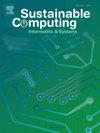基于ELCG-DSA和LWS-BiOLSTM的工业物联网入侵检测系统
IF 5.7
3区 计算机科学
Q1 COMPUTER SCIENCE, HARDWARE & ARCHITECTURE
引用次数: 0
摘要
工业物联网(IIoT)系统日益增长的连接性增加了网络威胁,需要及早发现入侵。然而,现有系统往往缺乏对工业物联网和工业控制系统(ICS)之间的中间和连续多因素授权的关注。为了克服这一问题,提出了一种基于指数线性同余发生器-数字签名算法(ELCG-DSA)和对数波s型双向一次长短期记忆(LWS-BiOLSTM)的工业物联网检测系统。最初,行业和车辆详细信息在区块链网络中注册,并通过智能合约创建多时变熵关联虎哈希算法(PEC-Tiger)生成哈希码。从生成的哈希码中,使用ecg - dsa技术创建部分数字签名。登录后,将使用Montgomery Modulo Curve Cryptography (MMCC)对已注册的详细信息进行处理,以增强安全性。然后,使用PEC-Tiger验证详细信息,如果哈希码匹配,则通知密钥生成中心创建完全数字签名。验证后,采用基于Luus-Jaakola序列的鹈鹕优化算法(LJS-POA)进行负载均衡。接下来,在IDS训练集中验证数据的安全性,IDS训练集中从预处理的数据中提取特征。然后,利用合成少数派过采样技术(SMOTE)进行数据均衡,并实现LWS-BiOLSTM对攻击进行分类。将被攻击的数据阻断,将未被攻击的数据通过数字签名验证保存在ICS中。因此,该框架的实验结果优于其他传统技术,达到98.78 %的准确率和98.71 %的安全水平。本文章由计算机程序翻译,如有差异,请以英文原文为准。
A predominant intrusion detection system in IIoT using ELCG-DSA AND LWS-BiOLSTM with blockchain
The growing connectivity of Industrial Internet of Things (IIoT) systems has increased cyber threats, necessitating early detection of intrusions. However, existing systems often lack focus on intermediate and continuous multifactor authorization between IIoT and Industrial Control Systems (ICS). To overcome this, an efficient IDS for IIoT using an Exponential Linear Congruential Generator - Digital Signature Algorithm (ELCG-DSA) and Log Wave Sigmoid-Bidirectional Once Long Short-Term Memory (LWS-BiOLSTM) is proposed. Initially, the industry and vehicle details are registered in the blockchain network, and the Polychoric Entropy Correlation-Tiger Hashing Algorithm (PEC-Tiger) generates hash codes through smart contract creation. From the generated hash codes, a partial digital signature is created by using the ELCG-DSA technique. After login, the registered details are processed for enhancing security using Montgomery Modulo Curve Cryptography (MMCC). Then, the details are verified by using PEC-Tiger, and if the hash code matches, the key generation centre is notified for the creation of a fully digital signature. After verification, the Luus–Jaakola Sequence-based Pelican Optimization Algorithm (LJS-POA) is applied for load balancing. Next, the data security is verified in the IDS training set, in which the features are extracted from preprocessed data. Then, the Synthetic Minority Oversampling Technique (SMOTE) is utilized for data balancing, and LWS-BiOLSTM is implemented to classify attacks. Furthermore, the attacked data is blocked, and non-attacked data is stored in the ICS through digital signature verification. Thus, the experimental results of the proposed framework outperform the other conventional techniques by achieving 98.78 % accuracy and 98.71 % security level.
求助全文
通过发布文献求助,成功后即可免费获取论文全文。
去求助
来源期刊

Sustainable Computing-Informatics & Systems
COMPUTER SCIENCE, HARDWARE & ARCHITECTUREC-COMPUTER SCIENCE, INFORMATION SYSTEMS
CiteScore
10.70
自引率
4.40%
发文量
142
期刊介绍:
Sustainable computing is a rapidly expanding research area spanning the fields of computer science and engineering, electrical engineering as well as other engineering disciplines. The aim of Sustainable Computing: Informatics and Systems (SUSCOM) is to publish the myriad research findings related to energy-aware and thermal-aware management of computing resource. Equally important is a spectrum of related research issues such as applications of computing that can have ecological and societal impacts. SUSCOM publishes original and timely research papers and survey articles in current areas of power, energy, temperature, and environment related research areas of current importance to readers. SUSCOM has an editorial board comprising prominent researchers from around the world and selects competitively evaluated peer-reviewed papers.
 求助内容:
求助内容: 应助结果提醒方式:
应助结果提醒方式:


